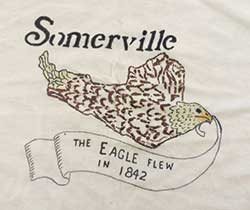
Eagle Feathers #183 – Tales From the Tree Tops
By Bob (Monty) Doherty
Somerville natives have always loved their trees, from the evergreens that Governor Winthrop hewn in building his ship, The Blessing of the Bay, to today’s dissent over how much shade they will cast over Beacon Street. Almost all of her trees were lost during the American Revolution when they were used to shelter thousands of English and Hessian troops imprisoned here.
Through the years, trees have embraced the city and its inhabitants in a myriad of ways. The first-known European shelter in Somerville was a wooden stockade built in the early 1620s. It was constructed in the Dane Street area and was protected by a palisade log fence.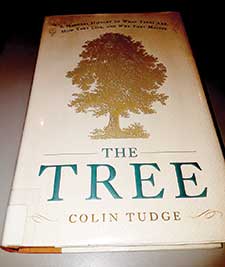
Before the revolution, permission from a king’s representative was required to fell a tree. The tall oaks and pines were earmarked for the British Navy. The only other option was a windfall or godsend, which was a tree that fell during a storm. In that case, the first person to find it could lay claim for its valuable wide planking.
While at Ten Hills, John Winthrop Jr. established the Saugus Iron Works where in 1652 the dies for the first American coinage were cast. These were the Massachusetts Bay Colony’s Pine Tree, Oak Tree, and Willow Tree shillings.
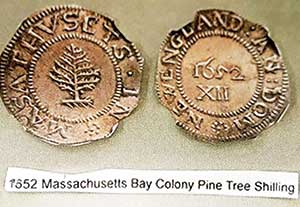
On April 19, 1775, the British troops commenced their land march to Lexington through Somerville. It was over a corduroy or log-made road leading through the marsh into Union Square and beyond. Within two months after the battles of Concord and Bunker Hill, the Americans had built seven earthen forts made of wood in preparation for the year long Siege of Boston.
Banes of colonial firefighters were trees and wood-thatched roofs. Combustible wood provided necessary lodging, shelter, furniture and tools. Oddly, trees provided wood for fighting fires in the form of hydrants, ladders, water pipes, fire tubs and pumps. Today, the department honors the mighty oak with its acorn- shaped badges.

Somerville identifies many of her trees with street signs. Exploring the city, you will find a forest of them which includes Cherry Street, Oak, Poplar, Maple, Willow, Chestnut, Ash, Cedar, Cypress, Beech, and Elm Street just to name a few. Prospect Street was originally called Pine Street; Wilson Square was formally known as Oak Square and Tufts College was built on Walnut Hill.
Not long ago, every young Somerville student was familiar with the beautiful poem, Trees, by Joyce Kilmer. Sergeant Kilmer was a young National Guard soldier killed in World War I in France a century ago. For many years it was said to be America’s most popular poem and was made more popular when African American baritone Paul Robeson put it to music.
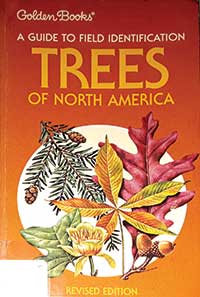
We don’t know how many trees there are in this city, but we do know that there are over 12,000 public trees alone and the biggest one is on Morrison Avenue. Some of these arbors we understand were scaled and pruned by an acclaimed writer who lived in Somerville while he was a tree cutter and climber. His name is Sebastian Junger, the author of The Perfect Storm and Fire, a story about smoke jumping fire fighters, and other international best sellers.
Somerville loves her trees. From the days when wooden protectors were put in place to stop horses from eating through their bark, to today’s boot protection of young trees from auto emissions.
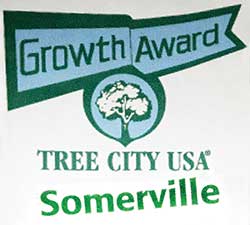












Reader Comments